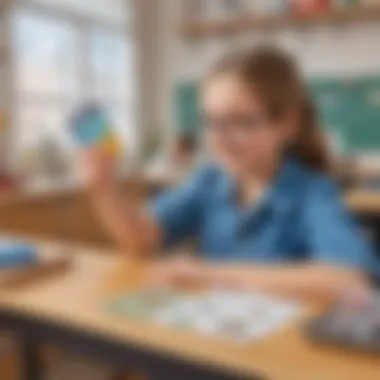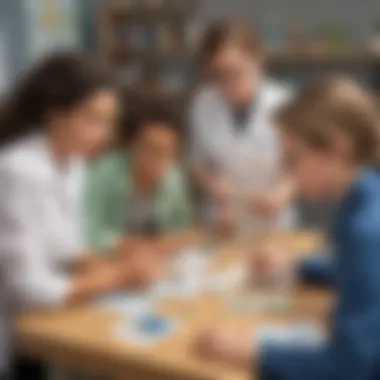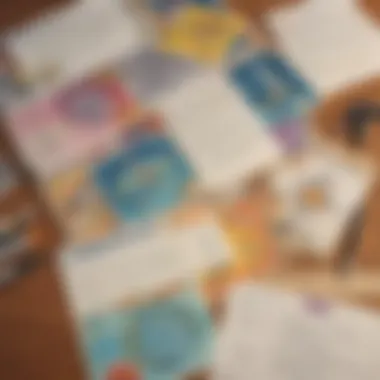Exploring STEM Task Cards: Engaging Young Scientists


Intro
STEM task cards are more than just tools; they are gateways to exploration and excitement in science. For children aged 6 to 12, these cards serve a dual purpose. They make science engaging and manageable while nurturing curiosity. Caregivers and educators can use these cards to enhance learning experiences. In this section, we will examine the importance of STEM task cards, how they function, and their unique benefits.
Science Fun Facts
Interesting Trivia and Facts
Science is filled with fascinating tidbits! For instance, did you know that honey never spoils? Archaeologists have discovered pots of honey that are over 3000 years old! Such facts are not just trivia; they can ignite a child's interest in learning more about science and nature.
Quirky Science Stories
One of the most unusual stories in science is about the discovery of penicillin. Alexander Fleming noticed mold growing in a petri dish. Instead of discarding it, he found that it killed bacteria! This serendipitous moment led to significant advancements in medicine.
Amazing Science Records
The tallest mountain in the world is Mount Everest, which is 29,029 feet high. However, if measured from base to summit, Mauna Kea in Hawaii is taller because it rises from the ocean floor.
Thought-Provoking Questions
What if we understood more about the universe? How would that change our lives? Such questions can stimulate critical thinking in young minds and spark a desire to explore scientific concepts.
Discover the Wonders of Science
Exploring Various Scientific Concepts
When children explore different scientific areas, such as biology or physics, they develop a well-rounded understanding of the world. STEM task cards can guide this exploration by breaking down these concepts into digestible formats with fun activities.
Educational Videos and Animations
Visual aids can make complex topics simpler. Resources like Khan Academy offer videos that explain various scientific concepts clearly. Viewing these can be an excellent way for children to absorb knowledge.
Interactive Learning Tools
Many online platforms offer interactive tools. Websites like PBS LearningMedia provide simulations that allow children to conduct virtual experiments. Engaging with these tools enhances their grasp of scientific principles.
Real-Life Applications of Science
Connecting science to everyday life can make lessons more relevant. Illustrating how scientific principles apply in real life—like using math in cooking—can help children understand their importance and use.
Science Quiz Time
Interactive Quizzes
Quizzes can enhance learning through fun challenges. Websites like Quizlet enable students to test their knowledge on various topics. They can sort and evaluate their understanding in a stress-free way.
Multiple Choice Questions
Asking children to answer multiple-choice questions can sharpen their decision-making skills. It encourages them to think critically about the material they studied.
Brain Teasers and Puzzles
Incorporating brain teasers can spark curiosity and promote problem-solving skills. Activities like these can be integrated with STEM task cards for a comprehensive learning experience.
Learning Through Gamification
Gamification has become a popular educational method. By implementing game-like elements, such as points or rewards for completing tasks, learning becomes more enjoyable.
Science Experiment Showcase
Fun and Engaging Experiments
Hands-on experiments are not only educational but also fun. Simple experiments, such as creating a volcano using baking soda and vinegar, can captivate young minds.
Step-by-Step Instructions
Tasks should have clear, step-by-step instructions for children to follow easily. This clarity fosters independence in learning and reinforces their confidence.
Materials List
An explicit list of materials is essential. Children should know what is required before starting an experiment, ensuring their safety and readiness.
Safety Tips and Precautions
Safety should always be a priority. Including safety tips on task cards ensures children understand the importance of being careful while conducting experiments at home or in class.
"STEM task cards transform passive learning into an interactive experience that fuels curiosity."
Preamble to STEM Task Cards
STEM task cards serve as a vital resource for young learners, particularly those aged 6 to 12. This section explores the significant value that these tools bring to science education. Task cards can ignite curiosity, encourage creativity, and promote an interactive learning environment that resonates with children.
These cards are not just simple worksheets; they encapsulate a wide range of activities designed to engage children in hands-on experiments and challenges. By offering diverse learning opportunities, STEM task cards help children grasp foundational concepts in science, technology, engineering, and mathematics.


Utilizing STEM task cards in education allows children to explore subjects actively. They provoke inquiry and promote independent thought, which is essential for nurturing the next generation of scientists.
Benefits of Using STEM Task Cards
- Increases Engagement: Children are more interested in learning when they can participate actively. Task cards provide a sense of exploration.
- Tailored Learning Experiences: Task cards can suit varying skill levels, accommodating those who might grasp concepts quickly as well as those who need more time.
- Promotes Critical Thinking: Engaging with task cards requires students to analyze and solve problems. This cultivates essential reasoning skills.
- Fosters Collaboration: Task cards can be designed for group work, promoting teamwork among young scientists. Working collaboratively enriches the learning experience and builds social skills.
Adopting STEM task cards in educational settings is a practical step towards modernizing the learning process. It reflects an understanding of how children learn best: through exploration and interactive engagement. As we move forward in this article, we will delve deeper into the definition, structure, and objectives of STEM task cards, along with strategies for effective implementation.
Understanding STEM Education
STEM education encompasses science, technology, engineering, and mathematics. It goes beyond teaching these subjects in isolation. Instead, it emphasizes the interconnections between these fields. Understanding STEM education is crucial for multiple reasons. First, it prepares students for a rapidly changing world. Jobs increasingly require a background in these areas. In addition, STEM promotes critical skills such as problem-solving and analytical thinking. These skills are not only applicable in STEM fields but across various life situations.
Another key aspect of STEM education is its focus on experiential learning. Engaging students in hands-on activities fosters deeper understanding. It allows them to apply theoretical concepts to real-world situations. For young learners, this approach can spark curiosity and enthusiasm. Moreover, it encourages collaboration. Working with peers on projects enhances communication skills and teamwork.
Importantly, STEM education prepares students for future opportunities. It encourages them to explore careers that might seem out of reach without proper guidance. This approach helps to demystify complex topics and shows students the tangible applications of their learning. Incorporating tools like task cards into STEM education can enhance these experiences further, making them accessible and enjoyable for young scientists.
Key Concepts of STEM
Understanding the fundamental concepts of STEM is necessary for effective learning. There are several core principles that underpin this educational approach:
- Integration of Disciplines: STEM education does not divide subjects but interweaves them to provide comprehensive knowledge.
- Problem-Based Learning: Students learn through solving real-world problems, which makes the education relevant.
- Innovation and Creativity: STEM encourages thinking outside the box, aiming to nurture future innovators.
- Real-World Application: Knowledge gained is applied to practical situations, ensuring relevance and interest.
These concepts form the backbone of effective STEM education and are essential for engaging young learners. Through initiatives like STEM task cards, educators can emphasize these principles while making learning interactive and fun.
What Are Task Cards?
Understanding what task cards are is essential for effectively integrating them into STEM education. Task cards are more than just pieces of paper; they are a versatile tool that encourages exploratory learning and active engagement. These cards can facilitate a range of activities, turning traditional learning into an interactive experience. The effectiveness of task cards lies in their ability to cater to different learning styles, allowing children to approach the subject matter in a way that resonates with them personally.
Defining Task Cards in Education
Task cards are instructional tools used in classrooms to guide student learning through focused activities. Each card typically presents a singular task or question that prompts critical thinking and creativity. They can be used across various subjects, but their application in STEM (Science, Technology, Engineering, and Mathematics) education is particularly relevant.
These cards can present challenges, experiments, or questions. For example, a science task card might ask students to describe how plants grow under different conditions. This kind of prompt encourages students to observe, hypothesize, and test their ideas. Task cards enhance motivation and provide structure, making them an effective way to explore complex subjects.
The Structure of Task Cards
When designing or using task cards, it's important to recognize their structure. A well-crafted task card usually contains specific elements that enhance its usability.
- Clear Objective: Each card should articulate a precise learning goal. This might include a question or a brief summary of what students should achieve.
- Instructions: Simple, concise directions enable students to follow the tasks without confusion.
- Materials List: If the task requires specific items, including a materials list can help students prepare in advance.
- Space for Responses: Cards often provide space for students to jot down their findings or solutions, fostering accountability and reflection.
"Task cards transform abstract concepts into tangible experiences, engaging young learners in ways that traditional methods often fail to achieve."
The Objectives of STEM Task Cards
STEM task cards serve distinct objectives in enhancing the educational journey of young scientists. They are more than simple worksheets; they are tools that drive engagement and deepen understanding. By implementing these cards, teachers and caregivers can help children develop vital skills that ensure a solid foundation in science, technology, engineering, and mathematics. The objectives focus on encouraging independent learning and fostering critical thinking skills. These elements are crucial in transforming passive learning into an interactive exploration of scientific concepts.
Encouraging Independent Learning
One of the primary objectives of STEM task cards is to cultivate a sense of independence in young learners. By providing clear instructions and targeted activities, task cards empower children to take charge of their learning. This sense of autonomy is significant because it helps students develop confidence in their abilities. For instance, when students can choose a task that interests them, they are more likely to engage fully with the subject matter. This process fosters ownership over their learning experience.
Moreover, independent learning nurtures the ability to solve problems without direct teacher intervention. Children encounter challenges while working on task cards, allowing them to navigate obstacles and determine the best solutions. This not only builds resilience but also develops important research skills. By seeking answers and experimenting with solutions, learners become active participants in their education.
Fostering Critical Thinking Skills
Another key objective of STEM task cards is fostering critical thinking skills. These task cards encourage learners to analyze situations, evaluate information, and draw conclusions based on evidence. Each activity is designed to challenge students intellectually, prompting them to ask questions and think creatively.
When children engage in STEM challenges or experiments through task cards, they learn to hypothesize and test their ideas. For example, a card might present a scenario where students need to construct a bridge using limited materials. They must consider structural integrity, materials used, and weight distribution. This problem-solving activity promotes logical reasoning and analytical skills.
"Critical thinking is essential for the development of students as they navigate a world filled with complex problems."
Integrating such activities into classroom settings encourages a culture of inquiry. Students learn the value of questioning and exploring concepts rather than memorizing facts. This active learning approach results in deeper understanding and retention of scientific principles.
Designing Effective STEM Task Cards
Designing effective STEM task cards is crucial for engaging young learners and promoting a deeper understanding of scientific concepts. These cards should not only serve as educational tools but also inspire curiosity and creativity among children aged 6-12. By carefully considering the elements that make up a task card, educators can create resources that enhance learning experiences, align with educational standards, and cater to diverse learning styles.
Identifying Learning Objectives
The first step in designing an effective STEM task card is to identify clear learning objectives. These objectives provide a roadmap for both educators and students. They clarify what students should know or be able to do after completing the tasks on the cards.
When formulating objectives, consider the following:
- Specificity: Objectives should be specific and measurable. For example, rather than saying "understand buoyancy," specify, "students will be able to conduct an experiment to test the buoyancy of various objects."
- Relevance: Ensure that the objectives relate to students' lives or real-world applications. This connection can boost motivation and engagement.
- Appropriateness: Objectives should be age-appropriate and aligned with the curriculum. This ensures that students are both challenged and capable of achieving the goals set.
"Learning objectives guide the educational process, providing a target for student achievement and a basis for assessment."
Incorporating Hands-On Activities
Incorporating hands-on activities is another essential element in the design of STEM task cards. Young learners benefit immensely from experiential learning, which allows them to engage with concepts through active participation. Hands-on activities make abstract ideas more concrete and relatable. Here are tips for effective incorporation:
- Diverse Activities: Offer a range of activities to cater to different interests and abilities. This might include experiments, building challenges, and creative projects.
- Clear Instructions: Provide clear, concise instructions that outline what students need to do. This minimizes confusion and maximizes engagement.
- Materials List: Include a list of materials needed for each activity. Ensuring these materials are accessible is vital for successful implementation.
- Variability: Allow for modifications or extensions of tasks so that students can explore topics in depth and at their own pace.
By focusing on learning objectives and hands-on activities, STEM task cards can be transformed into dynamic tools that motivate and educate young scientists effectively.
Implementing Task Cards in the Classroom


Implementing STEM task cards in the classroom is an essential strategy for enhancing student engagement and learning outcomes. These task cards allow teachers to introduce scientific concepts in a manageable and interactive way. Their structured design helps students remain focused while they learn through doing. Educators see important benefits when integrating these task cards into their teaching methods.
Using task cards effectively requires thoughtful planning and clear objectives. In teachers' daily routines, these task cards serve as a bridge between theory and practical application. They encourage students to think critically about the material and develop problem-solving skills. Often, students work in pairs or small groups, which adds a layer of collaboration to the learning experience.
Integrating Task Cards into Lesson Plans
Integrating task cards into lesson plans can happen easily with some preparation. Teachers should start by identifying key learning objectives corresponding to their curriculum. For example, if the focus is on the water cycle, the task card might include a simple experiment, such as creating a mini water cycle in a bag.
To integrate thoroughly, task cards can be introduced in several ways:
- Warm-up Activity: Present a task card at the beginning of class to stimulate interest and set the tone.
- Group Activities: Assign different task cards to groups and let them rotate, ensuring diverse experiences with various tasks.
- Assessment Tools: Use task cards as informal assessments to gauge understanding and application.
This structured approach ensures that task cards are not just add-ons but a core part of the learning experience.
Promoting Collaboration Among Students
Collaboration is a vital element in learning, especially in STEM education. Implementing task cards fosters a culture of teamwork in the classroom. Students feel safe taking risks while experimenting, knowing they have support from their peers. They engage in discussions that enhance their understanding of complex concepts.
Engaging activities with STEM task cards can promote collaboration in the following ways:
- Peer Teaching: Older or more proficient students can guide younger ones through their tasks, reinforcing their knowledge.
- Collective Problem Solving: When faced with challenges, students can brainstorm together, merging their ideas and approaches.
- Feedback Exchange: Students provide feedback to each other on their findings, facilitating a deeper grasp of the subject.
"Collaboration among students leads to richer learning experiences and fosters critical thinking skills.”
It is clear that STEM task cards not only facilitate learning but also promote essential life skills in collaboration and teamwork. These elements are crucial in preparing young scientists for future challenges.
Examples of STEM Task Cards
STEM task cards serve as a dynamic resource in educational settings. They not only engage young scientists but also provide a structured way to explore scientific concepts. Various examples can embody the principles of science and engineering effectively, making the learning experience both fun and informative.
Science Experiments
Science experiments are a core component of STEM task cards. These cards often guide students through hands-on activities that allow them to conduct experiments and observe outcomes. By doing experiments, children can grasp fundamental scientific principles. For instance, a card could present a task like creating a simple volcano using baking soda and vinegar, which exemplifies chemical reactions.
The importance of science experiments in task cards lies in their ability to stimulate curiosity. When children conduct experiments, they witness science in action. This practical experience deepens their understanding and retention of key concepts. Moreover, these activities intentionally include safety instructions and material lists, ensuring a safe environment for exploration. Teachers or caregivers can facilitate these experiments easily, enhancing cooperative learning experiences.
Some benefits include:
- Hands-on learning: Children learn best by doing.
- Critical thinking: Analyzing results encourages analytical skills.
- Measurement skills: Many experiments promote the use of measurement tools.
Engineering Challenges
Engineering challenges presented in task cards provide an opportunity for students to apply their knowledge creatively. These challenges might involve designing a bridge using popsicle sticks or creating a simple machine. Such tasks not only demand innovative thinking but also require practical problem-solving skills.
Like science experiments, these challenges encourage engagement. Students often work in teams, promoting collaboration and communication skills. They must discuss their ideas, experiment with various designs, and learn from each iteration. This process drives home the importance of persistence and teamwork in engineering.
Significant aspects of engineering challenges include:
- Collaboration: Working together aids social skills development.
- Resilience: Learning to adapt and improve designs fosters a growth mindset.
- Real-world application: Students can relate what they learn to everyday challenges they may face.
When students engage in engineering challenges, they learn that failure is a step toward success. The iterative process of design is critical in professional engineering.
These examples of STEM task cards highlight how effective they can be in enhancing learning experiences. By incorporating experiments and engineering tasks, educators can foster a hands-on approach to STEM education, making it both relevant and enjoyable for young minds.
Benefits of Using Task Cards
The importance of task cards in education cannot be overstated. They offer a unique, structured approach to learning that promotes both engagement and critical thinking among young scientists. By using task cards, educators can provide students with opportunities to explore scientific concepts in a hands-on manner. This is crucial for children aged 6-12, as they are in a formative stage where curiosity drives much of their learning. Task cards serve as a bridge, connecting theoretical knowledge with practical application.
One of the primary benefits of task cards is their ability to enhance student engagement. When learners use task cards, they often find the activities more interactive compared to traditional learning methods. This interactivity can lead to deeper exploration of science topics. Studies have shown that when students are actively involved in their learning, they retain information better. Children are more likely to remember what they learned when it results from a fun or enjoyable experience.
"Engagement in learning is not just beneficial; it is essential for fostering a deep understanding of scientific principles."
Another significant advantage is the support they provide for diverse learning styles. Not all children learn in the same way. Some are visual learners, while others may be more auditory or kinesthetic learners. Task cards can cater to these different styles effectively. For example, a task card with visual diagrams can aid those who learn better with images. Others might prefer hands-on experiments included in the task card to understand the concept better.
Additionally, the flexibility of task cards allows educators to customize them according to the needs of their students. They can easily modify the content or the activities based on the varying skill levels and interests of their students. This personalized approach promotes a more inclusive learning environment.
Moreover, task cards foster independence among young learners. As children work through tasks at their own pace, they develop problem-solving skills and self-efficacy. They learn to take initiative and responsibility for their learning, which is a key aspect of effective education. With time, this autonomy encourages students to become lifelong learners in the field of science.
In summary, the benefits of using task cards are numerous. They increase student engagement, support diverse learning styles, allow for personalized instruction, and nurture independent learning. All these factors contribute to a more effective educational experience, which can significantly impact a child's interest and success in STEM fields.
The Role of Educators and Caregivers
Understanding the role of educators and caregivers in the use of STEM task cards is essential for maximizing their effectiveness. Both educators and caregivers play pivotal roles in guiding children as they navigate and engage with scientific tasks. They not only provide guidance but also create an environment that fosters curiosity and enthusiasm for science.
Benefits of Educator and Caregiver Involvement
Educators and caregivers bring both knowledge and experience to the task cards. This involvement can shape a child's learning experience in several ways:
- Structured Learning: Educators help design task cards with clear learning outcomes. They structure the tasks to align with educational standards and learning objectives, ensuring that students gain relevant skills.
- Flexibility: Caregivers can adapt tasks to fit their child’s interests or learning pace. This flexibility allows for a personalized learning experience that may engage the child more effectively, making science enjoyable.
- Support and Encouragement: Both educators and caregivers can support students when they encounter challenges. This encouragement can enhance resilience and persistence in problem-solving.
Guiding Students Through Tasks
To utilize STEM task cards effectively, educators and caregivers must guide students through the tasks. This guidance involves several key considerations:
- Clarifying Instructions: It is critical to ensure students understand what is expected of them. Clear instructions can help prevent confusion and frustration, allowing students to focus on learning.
- Encouraging Inquiry: Asking open-ended questions can stimulate critical thinking. This approach shifts the focus from just solving the task to understanding the underlying concepts.
- Promoting Reflection: After tasks are completed, discussing what worked well and what didn’t can deepen understanding. Reflective thinking encourages learners to become aware of their learning processes and outcomes.
Evaluating Student Progress


Monitoring and evaluating student progress is crucial in any learning environment. For STEM task cards, this can be done through:
- Observation: Educators and caregivers can observe how students approach tasks, noting their engagement and problem-solving strategies. This can provide insights into a student's understanding and skills.
- Feedback: Providing constructive feedback helps students recognize areas for improvement. Specific suggestions can guide them in future tasks and enhance their learning experience.
- Assessment Tools: Utilizing tools such as checklists or rubrics can make it easier to measure progress. These tools can assess students' abilities in various areas, including critical thinking, creativity, and collaboration.
As we explore the use of STEM task cards further, it becomes clear that the collaboration between caregivers, educators, and students enhances the educational experience. The focused guidance and evaluation foster a rich learning environment where young scientists can thrive.
Challenges in Using STEM Task Cards
Using STEM task cards can be incredibly beneficial for enhancing children’s learning experiences in science. However, there are challenges that educators and caregivers need to consider when integrating these tools into the classroom. Understanding these challenges can help in effectively implementing task cards to maximize their potential.
Addressing Time Constraints
One of the primary challenges when using STEM task cards is time constraints. Many educators operate under strict schedules, making it difficult to incorporate additional activities like task cards into their lesson plans. Sometimes, science topics may not receive ample classroom time due to the competing demands of core subjects like math and language arts.
To address this issue, educators can evaluate existing lesson plans and identify areas where STEM task cards can be seamlessly integrated.
For example, rather than conducting a full science experiment, a task card can focus on the scientific method, allowing students to engage with the concepts without a lengthy time commitment. Planning ahead is crucial. Thus, think about assigning task cards as supplementary homework or during quiet periods in class. This flexibility can help prevent time from becoming a barrier to scientific exploration.
Balancing Curriculum Requirements
Another important challenge relates to balancing curriculum requirements. Educational standards often dictate what students should learn in each grade level, which can sometimes leave little room for supplemental activities. In many cases, educators feel pressured to cover standardized material, making creative approaches feel secondary. This leads to a situation where STEM task cards may not fit neatly into predetermined curriculum frameworks.
To navigate these constraints, educators can align STEM task cards with curriculum goals. Selecting task cards that target essential standards ensures students still meet educational expectations while engaging in hands-on learning. It may also be helpful to involve student choice in task card assignments. Giving students the ability to choose among various task cards can increase engagement and motivation while still adhering to educational goals.
To succeed in incorporating STEM task cards, adaptability and creativity are key.
Recognizing challenges upfront allows educators and caregivers to find workable solutions. By addressing time constraints and balancing curriculum requirements, STEM task cards can become a valuable part of the learning process. Such integration not only sparks student interest but can also foster a deeper understanding of scientific principles.
Future of Task Cards in Education
The future of task cards in education holds several possibilities that can transform the learning experience for young scientists. As technology continues to evolve, these educational tools offer unique avenues for engagement and exploration. Task cards can evolve from simple paper forms to rich, interactive experiences that cater to the diverse needs of students. This adaptability is crucial as educational environments are increasingly aiming to create personal learning experiences for every child.
The importance of task cards lies in their potential to foster investigation and inquiry-based learning. They can offer a structured approach for students while allowing them the freedom to explore concepts at their own pace, which many learners find beneficial. Moreover, the integration of task cards with emerging technologies can greatly enhance how students interact with STEM concepts. Educators can leverage these tools to not just prompt scientific thinking but also to guide children towards digital literacy and critical technological skills.
Technological Integration
The technological integration of task cards is essential in shaping their effectiveness and relevance in modern education. With tools like mobile applications and interactive software, task cards can be transformed into dynamic learning experiences.
For example, educators can create digital task cards that incorporate multimedia elements such as videos, simulations, and interactive quizzes. This can help students visualize complex concepts in science. The use of tablets or smartphones can also facilitate real-time feedback and assessment, making learning more engaging. When students receive immediate responses to their efforts, it reinforces their learning and keeps them motivated.
Here are a few significant aspects of technological integration in task cards:
- Interactive Content: Incorporating videos or simulations can enhance comprehension and retention.
- Collaboration Tools: Some platforms allow students to work together on tasks, encouraging teamwork and communication skills.
- Data Tracking: Educators can monitor student progress through digital platforms, enabling timely interventions and support when needed.
Trends in Educational Resources
The trends in educational resources are increasingly favoring active learning environments. Task cards are well-positioned to align with these trends, becoming a popular choice among educators. They support personalized learning, where students can explore topics at their own interest and pace.
One notable trend is the emphasis on inquiry-based learning. This approach promotes exploration and questioning rather than rote memorization. Task cards complement this shift well. They can inspire questions and challenges that lead to deeper understanding.
Current trends also highlight the need for inclusivity. Learning resources should address various student needs. Task cards can be designed to accommodate visual, auditory, and kinesthetic learners alike. This means creating versions of task cards that use diverse activities to engage all learners effectively.
Additionally, the rise of hybrid learning models—wherein classes are both in-person and online—means task cards can serve as versatile resources. They can be used in the classroom setting or as part of homework assignments.
"The integration of technology and progressive learning practices can reshape how students interact with STEM disciplines."
In summary, the future of task cards in education looks promising. Through embracing technological advancements and aligning with current educational trends, task cards can enhance the learning journeys of young scientists, nurturing curiosity and critical thinking.
Closure
In this article, we have uncovered various aspects of STEM task cards and their significant role in promoting scientific inquiry among young learners. STEM task cards provide a unique method for integrating hands-on activities with strong educational outcomes. They serve as pathways for children, aged 6-12, to engage actively in science, technology, engineering, and mathematics.
The importance of STEM task cards cannot be overstated. They allow students to cultivate curiosity and develop critical thinking skills, which are essential as they navigate their educational journey. By encouraging independent learning, task cards empower children to take ownership of their exploration, thus fostering a deeper connection to scientific concepts.
Additionally, caregivers and educators have a crucial role in facilitating this learning process. Their guidance and evaluation help shape the students’ experiences, ensuring that the tasks undertaken are both challenging and enjoyable. Educators can also address the challenges that arise in using these tasks effectively, promoting a balanced curriculum that maintains educational standards without sacrificing creativity.
As we look to the future, the integration of technology with task cards creates opportunities for even more engaging learning experiences. Online platforms and resources can expand accessibility and resource availability for both students and educators.
Ultimately, the potential of STEM task cards in education lies in their ability to inspire the next generation of scientists. These tools not only enhance learning experiences but also invite young minds to investigate the world around them through a structured yet flexible framework.
Resources for Further Learning
The concept of Resources for Further Learning plays a crucial role in enhancing the understanding and application of STEM task cards among young learners. This section will explore why these resources matter, offering parents and educators a guiding light in fostering a rich educational environment.
Young children often benefit from supplemental materials that support and expand their knowledge. Resources for Further Learning can include books, websites, videos, and interactive activities that encourage children to delve deeper into scientific concepts. By providing access to varied materials, caregivers can stimulate curiosity and promote independent exploration outside classroom settings.
Importance of Diverse Resources
- Encouraging Curiosity: Resources can ignite a child's interest in specific topics. For example, a child intrigued by plants might find books or online documentaries that inspire further inquiry.
- Supporting Visual Learning: Many young learners grasp concepts better with visual aids. Videos or infographics can complement task cards by providing a more dynamic learning experience.
- Addressing Different Learning Styles: Every child learns uniquely. Some may thrive with hands-on experiments, while others prefer reading. Having a variety of resources allows for adaptability to these individual needs.
Effective Types of Resources
- Books: Choose age-appropriate titles related to STEM subjects. Look for engaging narratives that illustrate scientific principles in everyday life.
- Websites: Platforms like Wikipedia and Britannica host rich entries on diverse topics, great for further reading and understanding.
- Videos and Tutorials: Educational platforms offering videos on scientific procedures can often clarify complex ideas more efficiently than text.
- Community Engagement: Local science fairs or museums often provide workshops that intertwine STEM learning with hands-on experiences.
"The best way to expand a child’s mind is to make learning enjoyable and accessible beyond the classroom walls."
Considerations for Selecting Resources
When selecting resources, balance is key. Ensure materials are not only informative but also engaging. Look for resources that invite questions. In this way, children can develop critical thinking skills alongside factual knowledge. Additionally, consider the credibility of online sources. As parents or educators, it's vital to vet materials beforehand to ensure they are age-appropriate and scientifically accurate.
By leveraging Resources for Further Learning, caregivers and educators can transform the STEM learning experience into an enjoyable, multi-faceted journey. This approach will not only pique interest in science but also lay a strong foundation for lifelong learning and exploration.







